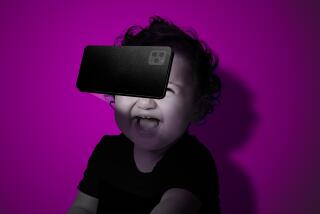Studies Find Parents Don’t Use TV Content Ratings
- Share via
NEW YORK — New studies out today echo previous findings that the V-chip ratings and a rule requiring TV stations to air three hours per week of educational or informational programming aren’t living up to their potential to guide children’s TV viewing, but, in a twist, this time parents get some of the blame along with TV outlets.
The three studies by the University of Pennsylvania’s Annenberg Public Policy Center find that even in a fast-changing multimedia world, where more families surveyed now have an Internet subscription than a newspaper subscription, TV content is the top concern of parents. Despite that concern, however, researchers found that parents aren’t using the available tools to find educational TV or to limit inappropriate content.
When the policies were first put in place, researchers wanted to see “whether or not people in the industry were living up to the mandate,” said Amy Jordan, senior researcher at Annenberg. “What we’re finding is that, for the most part, they’re doing it. The disconnect is between what they’re doing and what parents know and what parents are doing.”
Two in five parents have a V-chip or other form of technology to block out objectionable programming, one study found, and half of those with the devices use them. But the researchers found that awareness of the age and content ratings put on shows, such as TV-G (suitable for all ages), to be used in conjunction with the V-chips, has dropped from 70% in 1997 to just 50% this year. Furthermore, nine out of 10 parents couldn’t accurately identify the age ratings for a sample of shows their children watched.
This year’s studies were the first time Annenberg sat down for long discussions with parents and children of various ages to determine how the available information is being processed by families. What they found, Jordan said, was that parents “really don’t know some of the finer points of what the ratings mean.”
As for the three-hour rule requiring stations to air a minimum amount of educational/informational shows, the studies found that the networks are providing the programs, but parents don’t know which shows carry educational labels. Part of that blame, Annenberg said, goes to the poor promotional efforts of the networks, which rarely advertise them and don’t use a common symbol to identify those programs; for example, many parents didn’t realize that the lightbulb symbol ABC uses meant the shows were educational, Jordan said.
Furthermore, the study said, parents have no obvious place to look for such shows, and most TV listings in newspapers and TV Guide don’t carry the labels.
Among the studies’ findings: Some 70% of parents incorrectly identified “The Oprah Winfrey Show” and ABC’s “Who Wants to Be a Millionaire” as labeled educational for children, and 43% of families couldn’t name a single show they encouraged their children to watch. More than half (57%) of the children age 8 to 16 surveyed had a TV set in the bedroom.
*
But the studies also found that 91% of parents report watching TV with their children as a way to mediate what they watch, but that their choices are different than perhaps advocates of educational/informational programming would want: Families are more likely to watch “Who Wants to be a Millionaire” or the WB’s “7th Heaven,” about a minister’s family, than they are to watch educational-labeled shows. “At the very least, they’re innocuous,” said Jordan, “but that points to the discrepancy between what parents think is educational and what exists in terms of what’s designed to be educational.”
More to Read
The complete guide to home viewing
Get Screen Gab for everything about the TV shows and streaming movies everyone’s talking about.
You may occasionally receive promotional content from the Los Angeles Times.






